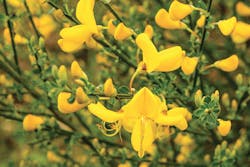Everyone in my hometown hated Scotch broom. If you’re not familiar, it’s a dark green shrub with bright yellow flowers that often contribute to seasonal allergies. It has thin, stiff branches, which are incredibly hard to break off. It’s also an invasive species, and a tenacious one at that. When digging up Scotch broom, it’s important to get as much of the root ball as possible, since any root that gets left behind can re-sprout.
When I was a child, my interest in Scotch broom was purely play based. We could pull off just the right number of leaves to make the downturned flower look like a woman in a bright yellow dress. My brother and I would whack each other with the whip-like branches when our parents weren’t looking. And no one ever yelled at us for tearing the foliage off Scotch broom. But as I got older, suddenly I started having seasonal allergies. I noticed Scotch broom turning up in places I didn’t want it, like my garden or my yard. And I became aware of what the Scotch broom was choking out—native plants like purple-blue lupines, tall pink fireweed, and delicate huckleberry bushes.
Managing vegetation is challenging. It means not only discouraging the invasive species we don’t want but encouraging the native ones that we do. There are many tools at our disposal, including herbicides, mulchers, soil remediation, and finding the appropriate seed mix. In this issue of Erosion Control, we highlight some of the options available for addressing our vegetation needs.
In “Building Strong Roots from Soil and Seed”, we look at how soil quality and appropriate seed selection go hand in hand. Whether it’s judicious application of compost, adding the right soil remediation, or finding the perfect native seed mix, the right seeds and the right soil are key.
In “Saving Labor, Saving Soil” a project in Baton Rouge, LA, had both steep slopes and depleted soil. The first attempt at establishing vegetation failed when a storm washed away compost, seed, and fertilizer, despite the use of straw and matting. A plan for revegetation was developed that would address both issues, and without increasing labor costs.
Finally, check out our “Equipment Highlight” for a look at the strengths and limitations of various pieces of compact vegetation management equipment, whether you’re trimming branches at the tops of trees or mulching thick brush.
So much goes into encouraging the plants we want to thrive and discouraging or removing those we don’t. Healthy soil and a good seed mix are vital, once we’ve removed the invasive, unmanageable, or just unwanted vegetation. Making sure you have the right tools will ensure success, no matter the size of the project.
Rachel Sim | Editor
As the editor of Stormwater magazine from June 2019 to December 2020, Rachel Sim created and curated quality content addressing the challenges faced by surface water and erosion control professionals, focusing on cutting-edge technology and the latest environmental research.






